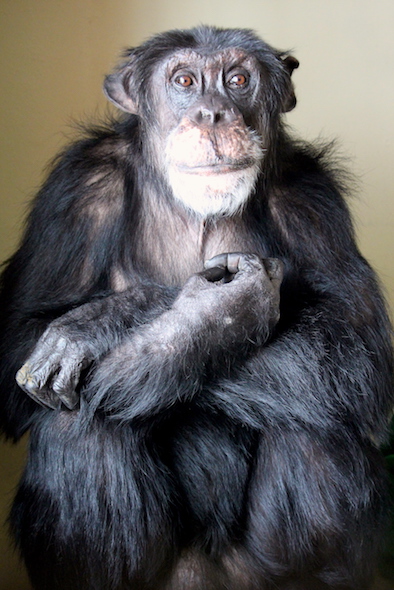The chimps spent the entire morning grooming one another on the playroom catwalk. Jamie began by directing her attention toward Negra, while Missy and Annie sat nearby grooming each other and occasionally breaking into gentle play. Further down, Burrito and Foxie paired off, each using one arm to groom while the other wrapped around their partner in a close embrace. Jody bounced from group to group until she somehow convinced them all to groom her at once.
There’s certainly nothing unusual about grooming; this is what chimps do. But you can detect a subtle difference in their grooming when there’s tension in the group. Their actions seem more calculated and strategic. Grooming begins to look more like what it really is – a form of social currency. You pay your rivals for forgiveness and reward your allies for their loyalty. Or maybe you use some of your currency to align yourself with someone who is moving up in the world. When the social order is knocked off balance, however slightly, it’s an opportunity to reshape it to your advantage.
The Cle Elum Seven chimps have been together as a group for about ten years, beginning in the lab and continuing here at the sanctuary. For captive chimps, that’s about as stable as it gets. But unfortunately, stability does not equal peace and tranquility.
There are a number of reasons why these chimps fight. One of the main proximate causes would have to be the chaos caused by the 115-pound ball of testosterone that we call Burrito. Burrito likes to start his day with a good dominance display, like many male chimpanzees do. His displays might include any combination of the following: pant hooting, screaming, pounding on the ceiling with his fists, rattling the cage doors incessantly, throwing things in the air, knocking over barrels, running through the enclosure while threatening to hit or kick his group mates, and/or actually hitting and kicking them. If you haven’t witnessed a prolonged display before, it’s hard to convey how agitating they can be. So while Burrito’s displays sometimes lead to a conflict between him and one or more of the girls, they are just as likely to lead to fights between the girls themselves. It seems that once everyone is riled up, it doesn’t matter who started it – any underlying tension is drawn to the surface to be hashed out.

Some of that underlying tension is due to the fact that dominance hierarchies aren’t static, regardless of how long the group has been together. Relationships change, as do personalities. Case in point: Annie is not the same chimp that she was eight years ago. Back then, she would have a panic attack if you looked at her funny. Now, she’ll take food from Negra and chase down Jamie or Burrito during a fight without hesitation. I don’t know if she’s alpha material, but she’s certainly not going to take flack from Jamie or Burrito anymore. As much as we all celebrate her newfound confidence, we also say a silent prayer each time that she doesn’t push things too far if she’s not prepared to fully back it up. In chimpanzee society, it’s best for everyone if you know your place.

Finally, we can’t forget that these chimpanzees were deprived of normal family life in a normal community. This lack of natural socialization causes more lasting damage than any medical testing they experience. In fact, it’s generally understood that chimpanzees from pet and entertainment backgrounds are much harder to integrate than chimpanzees from labs. Why? Because pet and entertainment chimps are particularly human-enculturated. They grow up learning our habits and our style of communication and our rules, and they have no connection to chimpanzee culture. Imagine the shock that Burrito and Jamie experienced when they were introduced to other chimpanzees later in life. And the others had it only marginally better when they were young, living in small nursery groups or in breeding pairs as they matured. In many ways it’s like Lord of the Flies. Without a culture to provide a guide for their behavior, they’re forced to make it up as they go. Frankly, I’m amazed that they can get along at all.

The Cle Elum Seven go through long periods of relative stability, punctuated by short periods of increased fighting with occasional wounding. As quickly as the tension and conflict arises, they reorganize or reaffirm their relationships and order is restored. On the surface, that is. Quiet bouts of grooming like the ones we witnessed this morning might seem like a complete absence of conflict, but look closer and you’ll see that they are actually part of the negotiation.




